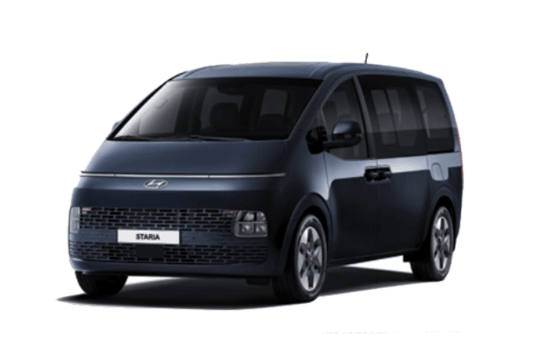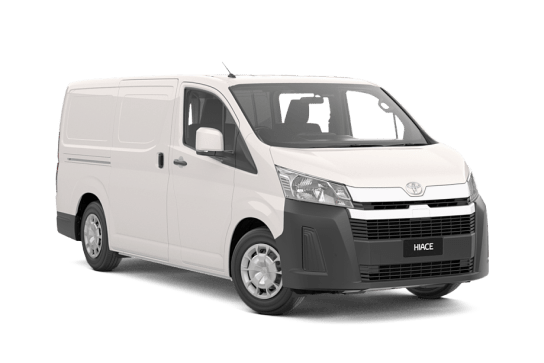
Hyundai Staria VS Toyota Granvia
Hyundai Staria
Likes
- Safety
- Performance
- Build quality/refinement
Dislikes
- Load volume
- Tow-ball download limit
- No adjustable lumbar support for driver’s seat
Toyota Granvia
Likes
- Plush interior
- Easy to drive
- Advanced safety tech
Dislikes
- Legroom isn't great
- Zero cargo space in eight-seat mode
- Thirsty
Summary
Hyundai Staria
Hyundai has established a reputation for quality light commercial vans in Australia, thanks largely to the solid foundations laid by the iLoad one-tonner launched locally in 2007.
For more than a decade it proved to be a popular alternative to Toyota’s dominant HiAce in the 2.5-3.5-tonne GVM van segment, building strong customer loyalty with competitive pricing, solid build quality, robust reliability, good fuel economy and driver comfort.
When iLoad production ceased in 2021 it was replaced by the all-new Staria Load, which switched from rear-wheel drive to front-wheel drive and introduced boldly futuristic styling.
Read more about
- 'The industry's all about hybrid': Hyundai Australia boss confirms importance of new Tucson Hybrid in taking the fight to the Toyota RAV4 Hybrid, joining Kona, Santa Fe and i30 sedan hybrid models to challenge market leaders
- Hyundai Inster 2025 review: Preview drive
- Hyundai changes course as EV sales slump, but the company has a plan it hopes will work and it could be great news for Australia
In 2024 the Staria Load, like its iLoad predecessor, is only outsold by the HiAce. So, we recently spent a week aboard the top-shelf model to see if it has what it takes to close the sales gap to its dominant Toyota rival.
| Safety rating | |
|---|---|
| Engine Type | 2.2L turbo |
| Fuel Type | Diesel |
| Fuel Efficiency | 7L/100km |
| Seating | 2 seats |
Toyota Granvia
Never talk to strangers. That's (hopefully) what your parents taught you. Luckily some people ignored that good advice when it came to the Toyota Granvia VX people mover and me.
As you'll see in the video above, I tested it on the public – people I didn't know from a cake of soap or whatever the saying is. Seriously, I drove a bus route and somehow talked people into not getting on their regular bus and letting me give them a lift to wherever they were going instead.
I don't often conduct social experiments like this, but I figured the Granvia VX was different. First, here was a new-generation people mover based on the Toyota HiAce that effectively replaces the long-serving Toyota Tarago. Second, it's different from the Tarago and rivals such as the Kia Carnival and Hyundai iMax in that it seems like it's purpose in life could be more of a hire car 'shuttle bus' as it is for a Mercedes-Benz Valente.
So, either way its job is to carry more than one person nearly all the time and that's what I did. You can watch the video above and below is the full review taking into account how I found the Granvia VX to drive, along with its practicality when it comes to cargo capacity, fuel economy and passenger comfort.
| Safety rating | |
|---|---|
| Engine Type | 2.8L turbo |
| Fuel Type | Diesel |
| Fuel Efficiency | 8L/100km |
| Seating | 8 seats |
Verdict
Hyundai Staria8.1/10
The Staria Load has good build quality, refinement, performance and pricing. In Premium specification, it also offers numerous desirable goodies that make it one of the best-equipped and sharpest-looking one-tonne vans on the market. For some buyers, depending on their requirements, it offers a compelling alternative to the ubiquitous HiAce.
Toyota Granvia7.6/10
The Granvia VX is great at being plush, comfortable and easy to drive, but it's not as practical as a people mover should be. And while the engine provides a great driving experience, you'll be filling up the tank often if your trips are mainly urban and city focused.
Does the Toyota Granvia miss the mark or is it the perfect combination of family hauler and professional shuttle bus? Tell us what you think in the comment below.
Design
Hyundai Staria
The Premium shares the same 3273mm wheelbase, MacPherson strut front suspension and leaf-spring beam axle rear suspension as all Staria Loads, along with power-assisted rack and pinion steering and four-wheel disc brakes. The Premium is available only with a swing-up tailgate.
Its 5253mm length and 1997mm width allows a turning circle of 11.94 metres (HiAce LWB is 11 metres) and its 2000mm height ensures access to height-restricted multi-storey carparks and underground loading docks.
The two-seat interior design, with its absence of physical dials and scarcity of buttons on the dash, provides a spacious and uncluttered workspace. However, adjustments like cabin temperature, fan speed, audio volume control etc using touch-sensitive prompts can be distracting while driving.
Even so, the brightly illuminated instrument display with its ‘virtual’ analogue speedo/tacho is mounted a long way ahead of the driver and quite high, so it almost works like a head-up display given its optimal positioning in the driver’s eyeline.
The height of the cabin doors is also conspicuously low, which has practical benefits given they are not far above knee height (like a LandCruiser 70 Series) which provides excellent side and forward-angle vision.
Toyota Granvia8/10
The Granvia is a new-generation people mover based on the Toyota HiAce commercial van and arrived in Australia in 2019. The resemblance to the HiAce is obvious although dressed up in its Granvia clothes it's a handsome and professional looking little bus.
I'm a fan of the protruding nose (which helped it earn the five-star ANCAP rating, see more on safety below) and I even like its big, shiny Transformer face and the 'L-shaped' tail-lights which aren't to everybody's taste.
Also, when I say little bus that's only in comparison to actual buses, like the one I convinced people not to get on in my video. Compared to a seven-seater SUV such as the Kia Sorento or Toyota Kluger, the Granvia is enormous.
Look at the dimensions. The Granvia is 5300mm long, 1990mm tall (not counting the aerial) and 1970mm wide, not counting the wing mirrors (which can be folded in).
While the length was hardly ever a problem for me while driving it over the week, the height saw me just make it under the 2.0m clearance in our underground carpark and I had to fold the aerial down to do it. Beware, many carparks have a max headroom of just 1.9m.
The cabin of the VX is impressively plush from the quilted leather reclining second-row seats to the 'woodgrain-look' trim throughout.
During my test I played bus driver to a number of passengers (no, seriously I picked up random strangers off the side of the road – see the video) and all were impressed by the Granvia's premium-feeling interior.
Practicality
Hyundai Staria
With its relatively light 1938kg kerb weight and 3020kg GVM, our test vehicle has a genuine one-tonne-plus payload rating of 1082kg (HiAce LWB is 1060kg) of which up to 100kg can be carried on roof racks.
It’s also rated to tow up to 2500kg of braked trailer (HiAce LWB is 1500kg) and with its 5520kg GCM (or how much it can legally carry and tow at the same time) that means it can legally tow its maximum trailer weight while hauling its maximum payload.
On face value, that’s a handy set of numbers. However, with a tow-ball download (TBD) limit of only 100kg it would be a challenge not to exceed that with 2500kg of trailer, given TBD is usually around 10 per cent of trailer weight.
The Premium’s solid-walled cargo bay, with 4.94 cubic metres of load volume (HiAce LWB has 6.2), is accessed through sliding doors on each side and a swing-up tailgate (no rear barn-door option is available for the Premium).
The doors and walls are lined to mid-height and although there’s internal lighting it could be brighter (preferably LED), particularly given the dark colour of our test vehicle.
The cargo bay is 2607mm long and 1640mm wide with 1250mm between the rear-wheel housings, which means it can (theoretically at least) carry up to two standard 1165mm-square Aussie pallets or up to three 1200 x 800mm Euro pallets, secured by a choice of eight load-anchorage points.
We say ‘theoretically’ because the raised tailgate effectively blocks rear access for forklifts not equipped with extendable tynes and the side-door openings are too narrow for an Aussie pallet to pass through.
So, if pallet-loading is important, a base model Staria Load with rear barn-doors would be a better choice than the Premium. However, for many other working roles a swing-up tailgate can be beneficial, particularly when serving as a large ‘umbrella’ during wet weather.
The cabin offers three tiers of storage in each door, with the lowest level providing a large-bottle holder and generously-sized bin.
There’s also a small-bottle/cupholder in the dash-pad to the driver’s right plus a handy compartment with clamshell lid in the centre, single glove box, full-width overhead shelf and pop-out cupholder.
Toyota Granvia7/10
The Granvia VX tested was an eight-seater (four rows of two seats) and being so tall and long would mean the space inside is going to be good, right? Nup. The Granvia doesn't seem to make the best use of its enormous cabin.
Seating, while undeniably comfortable and luxurious in the second and third rows, doesn't offer great legroom when you have a full load of people on board. I could only just sit behind my driving position in the second row and then behind that in the third row, but there was no way I could then fit in the fourth row.
And while cabin storage is great with the biggest centre console bin I've ever seen – I could fit my head in it (see the video) – and there are 10 cupholders, six coat hooks and a folding table, there isn't a boot or any room for cargo, not in the eight-seater (with all seats in use) I tested anyway. With all four rows in place there is only enough room for a few items no wider than a box of cereal (watch the video, to see what I mean).
Folding up the base on the fourth row seats means they can slide forward and that does free up a little bit of space for cargo, but if you are only going to be using the Granvia for six people, then my advice is to go with the six-seater and have a big boot at your disposal all of the time.
The Granvia VX is outfitted well with charging points – there are seven USB ports all the way back to the third row and two 12-volt outlets.
We'll get to what the Granvia is like to drive in a moment, but what I can say here is that the driver and passengers sit high, like looking-down-on-four-wheel-drive-utes high.
Access into the front seats is a bit of a climb up and proved tricky for my 75-year-old Dad with his gammy knee, but entry into the second-row seats was easy thanks to a wide step and a large aperture.
The small table between the second-row seats blocks the aisle, so the only way to get to the third row is by sliding the second row forward. Fourth row access is more difficult but compared to entry into the back row of most seven-seater SUVs it's a breeze.
Price and features
Hyundai Staria
Our test vehicle is the Staria Load Premium, which as its name suggests is a cut above the base model Staria Load Van. It comes equipped with the same 2.2-litre four-cylinder turbo-diesel and eight-speed automatic transmission shared by all variants, for a list price of $51,740.
Although that’s a sizeable $5000 more than the base model, it's lineball with the Toyota HiAce LWB in premium GL specification ($51,886). Our example is also fitted with some items from Hyundai’s impressive genuine accessories range, including the mesh-type cargo barrier ($916.75) and heavy-duty rubber cargo bay floor mat ($762.75).
Although our test vehicle is an MY24 build, it’s mechanically and (almost) visually identical to the latest MY25 Premium, which adds Hyundai’s ‘Bluelink’ connected car services, rain-sensing wipers and next-generation key fob.
That’s in addition to the Premium’s desirable standard features including 17-inch alloys with a full-size alloy spare, smart power tailgate, LED MFR (Multi Face Reflector) headlights, LED front light bar and LED tail-lights, high-beam assist, smart key with push-button start, big 10.25-inch instrument cluster and same-sized multimedia touchscreen, blind-spot-view monitor and automatic climate control.
It’s also enhanced by MY25 upgrades shared by all Staria Load variants including new 2D aluminium body-badging and additional USB-C ports, plus replacement of 'Blind-Spot Collision Avoidance Assist' with 'Blind-Spot Collision Warning' (see Safety).
Toyota Granvia7/10
We tested the Toyota Granvia VX eight-seater which lists for $74,990, before on-road costs, and sits at the top of the range. That said, there are only two grades in the line-up – the entry point known simply as Granvia which comes in six- ($62,990) and eight-seat ($64,990) versions and the Granvia VX which also comes in those two seating configurations and costs the same for both.
Standard features on the VX eight-seater include LED head and tail-lights, proximity unlocking, auto sliding side doors, power retractable heated wing mirrors, 17-inch alloy wheels, sun shades for all rear side windows, a 7.0-inch touchscreen with sat nav, Apple CarPlay and Android Auto, and a 12-speaker Pioneer stereo.
A special shout-out goes to the seating. Coming standard are quilted leather seats for the first, second and third rows, while the rear (fourth row) is a vinyl bench seat with a 60/40 split.
The second row consists of power adjustable ottoman style recliners - think business class airline seats, while the third row is a pair of manually adjustable captain's chairs, similar to the front seats which are power adjustable. My passengers loved the second-row seats. One even said, "I've never flown business class by I feel like I have now."
Is it good value? Well, not really. See $75K is a lot to spend on a Toyota people mover, especially considering the Tarago (which has been axed and effectively replaced by the Granvia) at its priciest is $65,261.
The top-of-the-range Kia Carnival Platinum lists for $62,790 and a Hyundai iMax Elite is even cheaper at $48,490. But the Granvia is a more premium offering, up there with the likes of the Volkswagen Multivan Highline for $79,890 or Mercedes-Benz Valente for $59,850
Under the bonnet
Hyundai Staria
The Euro 5-compliant 2.2-litre four-cylinder turbo-diesel produces 130kW of power at 3800rpm and 430Nm served across a 1000rpm-wide torque band between 1500-2500rpm.
This is paired with an eight-speed torque converter automatic, which offers the choice of more direct engine control using sequential manual-shifting. It also has overdrive on its seventh and eighth gears to optimise fuel economy at highway speeds.
Plus, there are four selectable drive modes comprising Normal, Eco, Sport and Smart, with the latter automatically switching between the other three to optimise performance and economy depending on variables like driving styles, road conditions, payloads etc.
Toyota Granvia8/10
The Granvia has a 2.8-litre four-cylinder turbo-diesel engine – the same one found in the Toyota HiAce van and with 130kW/450Nm I found there was more than enough grunt to handle city duties or overtaking on motorways.
Equipped with a diesel particulate filter there's a burn-off switch located near the driver's right knee. The Granvia will tell you when it's time to activate the burn-off function.
The 2.8-litre diesel is fairly quiet and responsive while the six-speed automatic shifts smoothly. There's not much to complain about in terms of the usability of the engine and transmission, they performed well – it's just that with it having to carry around a vehicle weighing nearly 2.7 tonnes fuel economy was never going to be great (you can read about this below).
Efficiency
Hyundai Staria
Hyundai claims official combined consumption of only 7.0L/100km. The dash display was showing 8.3 when we stopped to refuel at the end of our 270km test, which comprised a mix of city, suburban and highway driving, with about one third of that distance hauling a heavy payload. We also regularly switched between drive modes.
Our own consumption figure, calculated from fuel bowser and tripmeter readings, came in at 10.9, which was considerably higher than the dash was claiming. So, based on our ‘real world’ numbers, you could expect a driving range of around 680km from its 75-litre tank.
Toyota Granvia6/10
The specifications given by Toyota give the Granvia's combined fuel consumption as 8.0L/100km from the 2.8-litre four-cylinder turbo-diesel.
That sounds fantastic, but in reality after a combination of motorways and urban use the trip computer was reporting 12.9L/100km. A separate fuel test (carried out by myself) saw the Granvia use 21.4L over 127km of city and urban driving (measured at the fuel pump), which comes to 16.8L/100km.
That sounds like a lot, but it makes sense when you consider how heavy the Granvia is. It's 2660kg without anybody on board! If you're carrying eight people weighing 60kg your total mass is tipping the scales at 3140kg and your fuel economy is going to be significantly higher again. The GVM, by the way, is 3500kg.
Really, the Granvia is the perfect argument for a hybrid powertrain, because tour operators or parents ferrying their family around the city are going to want better fuel economy.
Driving
Hyundai Staria
The driving position feels spacious and comfortable for someone my height (186cm). However, given its Premium status, the driver's seat should have adjustable lumbar support for longer hauls. A fold-down inboard armrest would also be welcome.
The large doors mirrors, combined with blind-spot monitoring and different camera views (including the excellent blind-spot views that appear on the instrument panel) ensure good all-round vision.
This is one of the Staria Load’s strengths, given the huge blind-spot over the driver’s left shoulder created by all solid-walled commercial vans.
The steering is nicely weighted with a mild self-centre effect that ensures it tracks nice and straight over road surface irregularities.
Its unladen handling is stable and sure-footed, with a disciplined ride quality that’s supple enough to soak up the bumps without the lightly-loaded rear suspension bouncing around as you might expect in an empty one-tonner.
Engine response is energetic, as the eight-speed auto does a good job of keeping the turbo-diesel operating within its 1500-2500rpm maximum torque band most of the time. And it requires less than 2000rpm to maintain highway speeds.
Of the four drive modes available, we found ‘Sport’ the most engaging and enjoyable to use, with the instrument panel changing to a red colour and revised shift calibrations providing sharper engine response. This sporty effect is enhanced when using the sequential manual-shift function.
To test its payload rating, we used a forklift to load 650kg into the cargo bay through the side doors, which were just wide enough to allow this.
Combined with our crew of two, this was a total payload of 850kg (about 200kg under its limit). The rear suspension only compressed about 10mm, so there was no chance of its bottoming-out on our test route.
It felt even more planted on the road hauling this payload and coped well with our 13 per cent gradient, 2.0km-long set climb at 60-km/h in ‘Normal’ drive mode, self-shifting down to fourth gear to easily haul this load to the summit.
However, when testing engine-braking on the way down, in a manually-selected second gear, road speed was approaching the 60km/h limit when the transmission overrode our manual selection and shifted up to third gear when the engine reached 3750rpm.
These engine-protecting shift calibrations are common in light commercial vans, which is great for mechanical longevity but not much use when you’re leaning on the engine to assist with braking on steep descents. Fortunately, the four-wheel disc brakes easily coped with the increased workload.
We should also mention the internal noise levels when travelling at highway speeds, given the lack of a solid bulkhead between cabin and cargo bay. Tyre roar emanating from the rear-wheel housings, not helped by the unlined upper walls and roof, can become intolerable over long distances. Fortunately, Hyundai offers a solution with a solid bulkhead ($1825.63) in its genuine accessory range.
Toyota Granvia8/10
For a 5.3m long, 2.0m tall box on wheels the Granvia sure is easy to drive. I live in Sydney's Inner West (get your chai latte jokes out of the way now, please) and drove it daily through horrendous traffic on potholed roads, navigated through the tiniest streets and squashy car parks, went fishing in it and ate up motorway kays on the weekends.
There are going to be people who snort at that eight of 10, but I'm telling you it's down to three things: comfort, ease and engine.
The seats were comfortable and supportive (my passengers felt the same way – again see the video of me being a bus driver), the ride is composed thanks to the suspension and no doubt the weight and the wheelbase of the Granvia.
The visibility is excellent thanks to those giant windows, the ride height and tech such as that digital rear view mirror, while the steering is light, and the turning circle is excellent at 11.0m.
Finally, that 2.8-litre turbo-diesel engine. Yes, it's thirsty but from a driving perspective only it's great – smooth and responsive.
Often vans are prone to a booming sound reverberating around the cabin and the Granvia VX was also a victim of this phenomenon with road noise echoing around inside. It's not bad and I could still hear people in the second and third rows, however.
Safety
Hyundai Staria
The Staria boasts a maximum five-star ANCAP rating achieved in 2021 (expires 2027). It comes with seven airbags and comprehensive ‘SmartSense’ active safety and driver assistance technologies.
MY25 safety upgrade includes replacement of 'Blind-Spot Collision Avoidance Assist' (BCA) with 'Blind-Spot Collision Warning' (BCW) across the range. BCW monitors for vehicles in the blind-spot areas to give the driver audible and visual warnings as required.
Toyota Granvia9/10
The Granvia scored the maximum five-star ANCAP rating when it was tested in 2019. The amount of standard safety equipment is outstanding, particularly for a van with commercial origins.
Coming standard are nine airbags including ones which go all the way back to cover the fourth row and for child seats there are four ISOFIX points (second and third rows) and four top tether points (second and third rows).
The level of advanced safety equipment is also outstanding. Coming standard is Toyota's 'Safety Sense' pack which brings AEB with cyclist and pedestrian detection, lane departure alert with steering assistance, road sign recognition, auto high beam and active cruise control.
A full-sized spare wheel is located under the Granvia VX.
Ownership
Hyundai Staria
Hyundai covers the Staria with a five-year/unlimited km warranty.
Scheduled servicing is every 12 months/15,000km whichever occurs first. Capped-price servicing for the first five scheduled services up to five years/75,000km totals $2375 or an average of $475 per year.
Toyota Granvia8/10
The Granvia is covered by Toyota's five-year, unlimited kilometre warranty. Servicing is recommended by Toyota at six-month/10,000km intervals with capped price servicing of $240 per service for three years or 60,000km.




